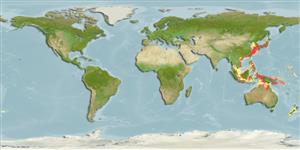Environment: milieu / climate zone / depth range / distribution range
Ecology
Marine; demersal; depth range 38 - 150 m (Ref. 9774). Tropical
Western Pacific: Japan, Korea, and Indo-China.
Size / Weight / Age
Maturity: Lm ? range ? - ? cm
Max length : 26.8 cm TL male/unsexed; (Ref. 106388); common length : 12.0 cm SL male/unsexed; (Ref. 9774); max. published weight: 208.70 g (Ref. 106388); max. reported age: 3.00 years (Ref. 47703)
Dorsal spines (total): 0; Dorsal soft rays (total): 68 - 76; Anal spines: 0; Anal soft rays: 53 - 57; Vertebrae: 35 - 36. Body pale brownish, with 2 ocelli above and below lateral line and 1 ocellus on posterior third of straight section of lateral line. Teeth in upper jaw small and close-set. Gill rakers long and slender. Soft ray count of pectoral fin refers to that on ocular side (Ref 9774). Body with many ocelli (Ref. 559).
Inhabits mud and sand bottoms of the continental shelf (Ref. 9774, 11230). Feeds on small benthic crustaceans and fishes (Ref. 9774). Marketed fresh and salt-dried (Ref. 9774).
Life cycle and mating behavior
Maturity | Reproduction | Spawning | Eggs | Fecundity | Larvae
Distinct pairing (Ref. 205).
Robins, C.R., R.M. Bailey, C.E. Bond, J.R. Brooker, E.A. Lachner, R.N. Lea and W.B. Scott, 1991. World fishes important to North Americans. Exclusive of species from the continental waters of the United States and Canada. Am. Fish. Soc. Spec. Publ. (21):243 p. (Ref. 4537)
IUCN Red List Status (Ref. 130435: Version 2024-2)
Threat to humans
Harmless
Human uses
Fisheries: commercial
Tools
Special reports
Download XML
Internet sources
Estimates based on models
Preferred temperature (Ref.
123201): 16.7 - 28.1, mean 26 °C (based on 299 cells).
Phylogenetic diversity index (Ref.
82804): PD
50 = 0.5000 [Uniqueness, from 0.5 = low to 2.0 = high].
Bayesian length-weight: a=0.00631 (0.00374 - 0.01065), b=3.16 (3.01 - 3.31), in cm total length, based on LWR estimates for this species & Genus-body shape (Ref.
93245).
Trophic level (Ref.
69278): 4.0 ±0.67 se; based on food items.
Resilience (Ref.
120179): High, minimum population doubling time less than 15 months (tmax=3).
Fishing Vulnerability (Ref.
59153): Low vulnerability (17 of 100).
